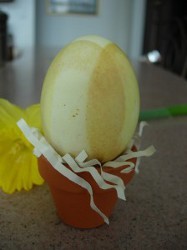Eco Friendly Easter Egg Dye
Say goodbye to harsh chemicals and hello a fun Easter craft for adults and kids alike! Eco-Friendly Easter Egg Dye from Tiffany Windsor uses elements found in nature. No need to worry this holiday season! Have fun and get creative instead.

Materials:
- Eggs (white eggshells preferred)
- Water
- Pans (for boiling eggs and for simmering dyes)
- Vegetables, herbs, berries (I used beets, blueberries, onion skins, turmeric, red cabbage, alkanet)
- Kitchen string, rubber bands, stickers and other materials for embellishing eggs
- Easter grass, Easter basket or small clay pots for display
Instructions:
- Boil eggs for 15 minutes. Let cool to room temperature or place in refrigerator overnight.
- Prepare dye according to instructions by simmering your veggies, herbs or berries. Let cool and pour into dipping bowls. Remember that you will want the bowl deep enough to immerse entire egg.
- Decorate eggs with string or stickers or rubber bands.


- Place decorated eggs into dye baths for several hours or until desired color is achieved. Remove from dye bath and let set on paper towel. Do not rub excess dye as you may remove more color than desired. (Although a cool looking technique is to dab with paper towel or plastic wrap to create interesting textured design.)
- Carefully remove decorations to reveal design. Let eggs dry completely and display in basket filled with Easter grass or tiny clay pots.

- To create this layered color effect, pour a small amount of dye into the bottom of a bowl. Place egg into dye bath. Rotate egg 1/4 turn every hour to create color layers.
For a video tutorial of this project, check out How to Create Natural Dyes for Easter Eggs.
Want to learn more about natural dyes for Easter eggs? Check out "Easter Eggs: Easter Egg Designs, Tips for Perfect Hard Boiled Eggs, Egg Recipes" free eBook.
Read NextSilk Tie Easter Eggs
Your Recently Viewed Projects
quanahs 5032097
Mar 03, 2016
This is great and a wonderful, eco friendly way to make Easter eggs. I love love love the muted colors and the shabby look. It may take a little longer to create these eggs, but its always nice to know that any dye seeping through the shell is just a little bit of edible plants. Thank you so much for sharing.
Report Inappropriate Comment
Are you sure you would like to report this comment? It will be flagged for our moderators to take action.
Thank you for taking the time to improve the content on our site.
















